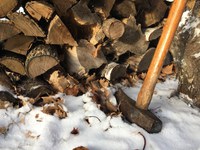Dakota Gardener: The Warmth of a Good Fire and Good Friendship
(Click an image below to view a high-resolution image that can be downloaded)
By Joe Zeleznik, Forester
NDSU Extension
As we all know, 2020 has been an interesting year.
My wife and I have been very fortunate; we’re healthy and we’ve been able to visit with a few of our neighbors about once a month. These get-togethers have all been outdoors and usually there’s a small bonfire involved.
One of our friends already is worried about winter, though. Will we be able to see each other at all? My response is, “Absolutely! We just need warmer clothes and bigger bonfires.”
Relatively few households use wood as their main source of heat, although the percentage has increased in the last 20 years as outdoor wood furnaces have become more common. Indoor wood stoves also are relatively uncommon, although not unheard of.
When I was in graduate school in West Virginia, we actually had a wood-burning stove as a secondary source of heat for our small rental house. Otherwise, we used electric baseboard heating. That wood stove saved us a lot of money when funds were tight.
A very unique wood-heated facility in North Dakota is at Bismarck State College. The BSC Aquatic Center burns wood waste from the Bismarck Forestry Department’s pruning program. It’s a great use of a resource that otherwise might go to waste. Many municipal forestry programs offer wood to residents, although you’ll probably have to do the cutting and splitting yourself.
How much heat does wood give out? I’ve looked into this question a lot through the years and I’m always surprised by the answers. Pound for pound, most hardwood (deciduous) tree species contain roughly the same amount of heat – about 8,600 British thermal units (BTUs) per pound (https://extension.missouri.edu/media/wysiwyg/Extensiondata/Pub/pdf/agguides/forestry/g05450.pdf). Bur oak, boxelder and even cottonwood all hold a similar amount of heat by the pound.
But firewood is rarely sold by the pound. Instead, it’s usually sold by volume – by the cord. What’s a cord? It’s a stacked pile of wood, bark and air space that measures 4 feet high by 8 feet wide by 4 feet deep. A “face cord” is a stacked pile that’s 4 feet high by 8 feet wide by X feet deep. X is usually 16, 20 or 24 inches, based on what size a given stove or fireplace can take.
For my own firewood, I’ll take the oak instead of cottonwood any day. Oak is much denser than cottonwood and we have limited storage space. Although boxelder is pretty abundant, oak is a lot easier to split.
I like to let my firewood dry for at least a year before using it. Cottonwood contains an amazing amount of water, and once the wood dries, it’s very light and puts off very little heat.
There’s an old saying about firewood that goes like this: Firewood heats you three times. The first is when you cut it. The second time is when you split and stack it. The third time is when you finally burn it.
My wife and I likely will have a few fires in the fireplace this winter. It’s very comforting on a cold, windy night. And maybe on those occasional calm days, we’ll go outside and have a bonfire with our friends. That’ll keep us warm.
For more information about gardening, contact your local NDSU Extension agent. Find the Extension office for your county at https://www.ag.ndsu.edu/extension/directory/counties.
NDSU Agriculture Communication - Nov. 17, 2020
Source: Joe Zeleznik, 701-231-8143, joseph.zeleznik@ndsu.edu
Editor: Ellen Crawford, 701-231-5391, ellen.crawford@ndsu.edu




